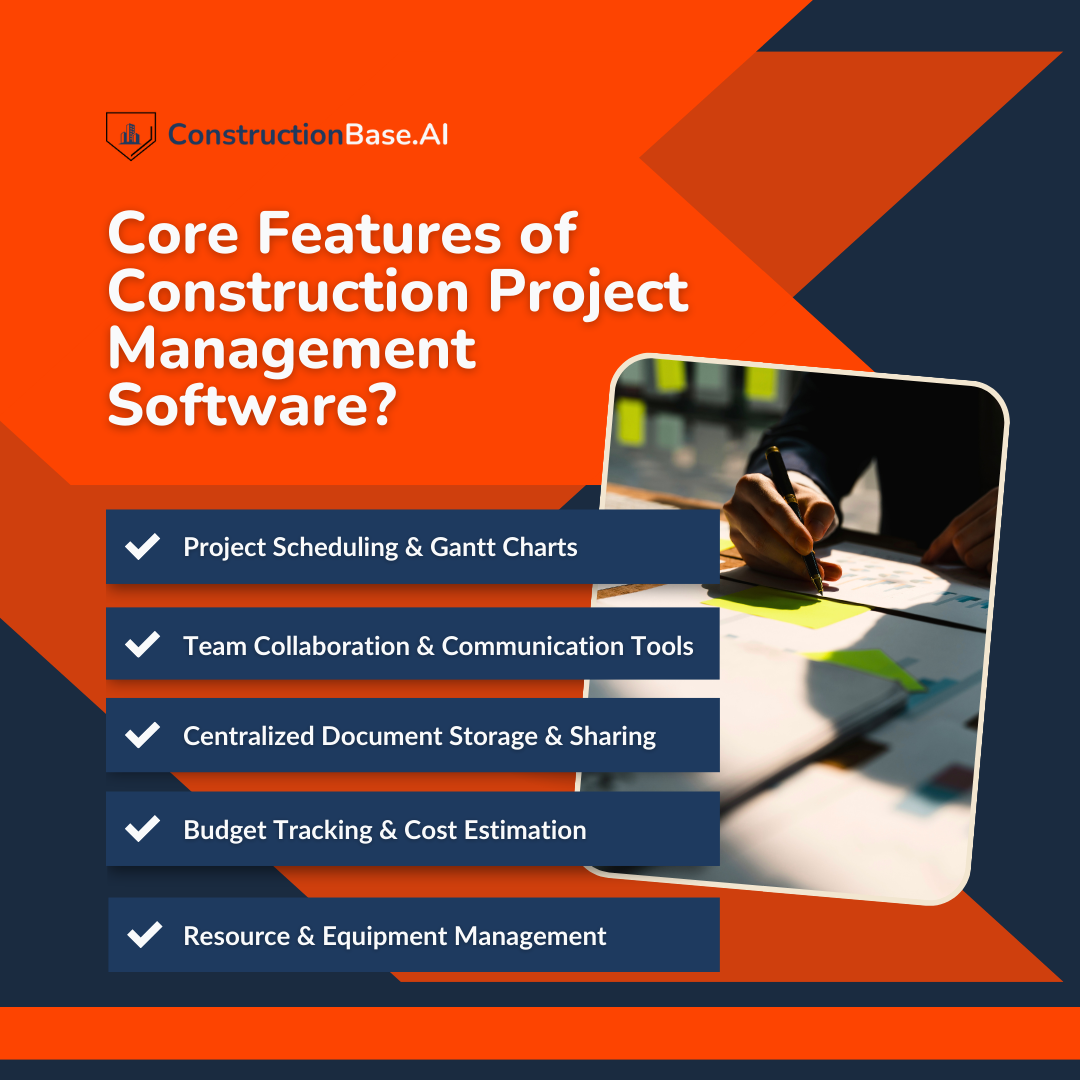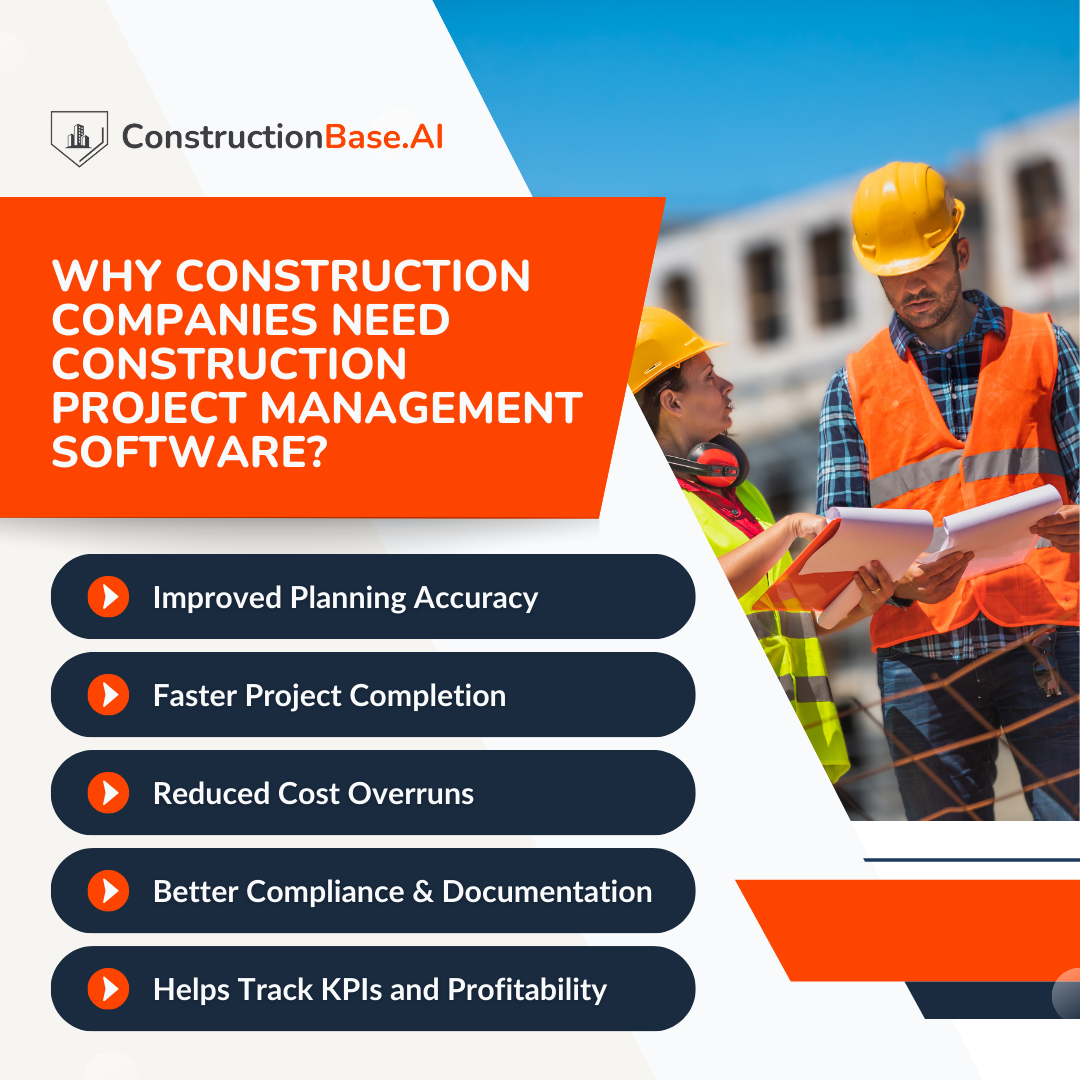Audio Overview: Listen & Learn
You visit many sites and, most of the time, land on those where nothing is on track! One site is delayed because materials arrived late, another is over budget from undocumented change orders, and the third? Maybe you and the client both don't know what's happening there!
All you need is a tool that stays with you everywhere, from the muddy job site to the client meeting room. And that tool is construction project management software that understands your work language.
Unlike generic software that treats your projects like office paperwork, construction-specific software understands your site's unique chaos.
It understands that weather delays happen, that field conditions alter plans, and your crew and clients need information that can't wait.
So, let’s see how this modern construction software can help you deliver projects on time that leave clients excited to collaborate with you again.
Key Takeaways
- Key features of construction software include project scheduling, team collaboration, document storage, budget tracking, cost estimation, resource management, and mobile access.
- How it benefits: Improved planning accuracy, faster project completion, reduced cost overruns, real-time communication, scalability, and tracking KPIs and profitability.
- The top construction project management software in 2025: Constructionbase, Procore, Fieldwire, Buildertrend, and Autodesk.
What is Construction Project Management Software (and why do you need one)
Imagine having five separate apps active on your phone versus using a single app that fulfills all your needs. Unlike generic project management tools that overlook the complexities of building projects, this tool is tailored for specific construction challenges.
Construction Project Management Software (CPMS) is a digital tool designed to manage and optimize different facets of your construction project, from planning and budgeting to on-site execution.
It centralizes information, automates tasks, tracks progress, and enhances communication, ultimately assisting you in delivering projects on time, within scope, and on budget.
So why exactly do you need this software? Because:
- Your competitors are already employing it.
- Your margins are too thin to waste money on avoidable mistakes.
- Your team spends too much time on non-productive activities.

And it shows in the numbers!
Research indicates that construction professionals in the U.S. waste 35% of their time on non-productive tasks, such as conflict resolution and data searching, leading to a loss of 14 hours per week for each employee.
In short, you need it because construction is complex enough without adding unnecessary difficulties.
And that's less chaos, more control! Now, let's identify the key features that make great software stand out.
Core Features of Construction Project Management Software?

1. Project Scheduling & Gantt Charts
First up, hectic construction project schedules!
You created a schedule that fell apart when just one task changed! We’ve all experienced that.
Well, leave it to Gantt charts now!
- They serve as visual timelines, allowing you to outline each project phase from excavation to handover.
- Their real advantage? Their interactivity; adjust one task, and all hanging tasks automatically realign.
2. Team Collaboration & Communication Tools
Let's be honest: Miscommunication is more expensive than concrete in the construction industry.
The architect emailed revised plans, but the subcontractor missed them, and the client saw the wrong design. Plans were messed up before they even started!
The right collaboration tools eliminate the "I never got that message" problem by providing:
- Real-time chat in the app:
For example, “@Team: Revised plans uploaded. Confirm by EOD.” - Task comments replace chaotic email chains.
3. Centralized Document Storage & Sharing
You must have spent hours searching for “that one document” hidden somewhere in your inbox?
Yeah, happens right (maybe every time)?
What happens when you have the right software at hand?
- Cloud storage covers everything from A to Z: latest plans, permits, and punch lists.
- Version control automatically saves changes.
- Mobile access allows you to access specs on-site without needing Wi-Fi.
4. Budget Tracking & Cost Estimation
Construction budgets don’t manage themselves. Just one minor cost overrun and your profit margins disappear.
But, with real-time budget tracking and forecasting tools, you can see exactly where every dollar goes:
- Track expenses throughout the project.
- Compare calculated vs. actual costs.
- Forecast overruns before they happen.
5. Resource & Equipment Management
A project will fall behind schedule if your team arrives without the necessary equipment or is left unused at a different job site.
With the power of software, construction project managers can easily:
- Assign labor and equipment to specific tasks.
- See who and what is available in real time.
- Avoid double-booking or rental overruns.
6. Field Reporting & Mobile Access
Most of the time, you are probably waiting in the field, wondering what happened while you were away from the site!
The best platforms come with robust mobile apps that allow site supervisors and field crews to:
- Submit progress reports
- Upload site photos
- Log safety incidents
- Update task statuses
7. Compliance, Safety & Risk Management
Safety comes first, always!
However, remaining compliant with regulations and handling risks can seem like a full-time job itself.
How about built-in safety tracking and risk management features?
- Automated checklists.
- Incident logs are auto-filed to HQ and insurers.
- Audit trails proved that training was finished
8. Reporting & Analytics Dashboards
Data is a superpower, but it’s only effective if you can utilize it. Static spreadsheets are no longer sufficient.
The remarkable ability?
- Identifying bottlenecks and inefficiencies: spotting patterns that wouldn't be visible in spreadsheets.
- Monitoring KPIs like productivity rates, safety incidents, and quality issues.
- Providing early warning of potential issues before they impact the schedule or budget.
And who doesn’t want these powers? So, how about we jump to....
Why Construction Companies Need It (Benefits Section)

Did you know?
FMI estimates that poor communication costs the U.S. construction industry approximately $17 billion per year, while poor project data contributes an additional $14.3 billion, totaling a potential annual cost of $31.3 billion.
So, how does a Construction project management software help you out?
1. Improved Planning Accuracy
Reflect on the last project where your estimate was accurate. Maybe there's no such memory!
With the right project management software, you're not just planning based on gut feelings or optimistic assumptions.
You're leveraging actual data from past projects, not what was supposed to happen, but what actually happened.
2. Faster Project Completion
Every day a project runs over, you lose margin and slowly the client's trust.
With automated scheduling, real-time updates, and team coordination all in one place, you eliminate the lag time that typically slows things down.
Consider your usual 12-month project. Imagine completing it 4-5 weeks ahead of schedule. How would this impact your profits? Answer:
Decreased overhead costs, reduced equipment rental fees, satisfied clients, and the chance to start your next project sooner.
3. Reduced Cost Overruns
Here's a startling statistic: 9 out of 10 construction projects encounter cost overruns!
Perhaps it’s labor, perhaps it’s materials, or possibly it’s poor communication. Regardless, it eats into your profit.
Good software helps you be among those who can undertake construction projects without facing this challenge. It provides clear insights into budgeted versus actual expenses, notifications for overspending, and improved management of change orders.
4. Real-Time Communication = Fewer Delays
The common origins of construction delays: waiting for information! Still waiting!
A missed message, a forgotten schedule, an outdated plan! Suddenly, a one-day delay turns into a week.
Software fixes this with centralized communication. Your team, subcontractors, and clients can all collaborate on one site, with instant notifications, tagging, and mobile updates.
5. Better Compliance & Documentation
Let’s be honest: Inspections, permits, safety checklists, contract documents, and logs are all important yet overwhelming.
Good news? With project management information systems, it's easy! All your documents are organized, searchable, and kept in the cloud.
Whether preparing for an audit or managing a client dispute, your records are accessible with a few clicks.
6. Scalable for Small, Mid & Large Projects
Construction challenges remain the same irrespective of construction methods and project size.
The right software is flexible to projects of all sizes, allowing small companies to focus on core features, mid-sized contractors to customize workflows, and large enterprises to standardize practices.
7. Helps Track KPIs and Profitability
The most profitable benefit is here! Measure, analyze, and manage better with insights!
This provides real-time insight into your business performance and highlights what needs to be changed for improvement.
This information helps you to track ongoing projects, bid for future work more effectively, and pinpoint opportunities for operational improvement.
Find out the Benefits of Integrating Construction Software into Your Business Operations.
How does a Construction Project Management Software work(A Day in the Life of a Construction PM Using Software)
Here's a walk-through of a project manager's day and see how the right tools work hand in hand with the right project management skills.
Imagine you are a construction project manager, and let's start the day!
1. Morning Planning: Dashboard + Alerts
With the sun rising, you begin your day by accessing the project dashboard.
All key alerts, including deliveries, pending approvals, and upcoming milestones, are shown at a glance.
The beauty of a dashboard? No guesswork, no headache! You can prioritize tasks, check team availability, and ensure that everything remains on schedule, all before finishing that first cup of coffee.
2. Task Assignment to Field Teams
Once the priorities are clear, it’s time to assign tasks to field teams.
You use the software's task management feature rather than making numerous calls or sending multiple messages. No more chasing updates; everyone knows their tasks clearly.
3. Live Updates from Site via Mobile App
Your phone vibrates. The field team needs help.
Your foreman takes a picture of the problem, mentions you in the app, and adds a note: “Need engineer approval here.”
You: Check the latest update on your dashboard. Involve the engineer using @mention. Approve a fix instantly, directly from your phone.
Done there and there without visiting the construction site physically!
4. Budget Tracking with Real-Time Material Costs
At midday, you check the budget tab.
You realize that material costs for Project A are increasing more quickly than anticipated because of a rise in material prices. However, the advantage is that your software retrieves live data and alerts you before it becomes a financial issue.
You modify the forecast, engage with procurement, and swiftly contact the supplier for alternatives, all before lunch.
5. Client Communication via Shared Portals
Your client has sent a “quick question.” Don't worry.
Rather than sifting through emails, you: Log into the client portal to share updates, send a progress report, and answer their question.
Client’s reaction: They appreciate your speed and transparency. And you just avoided a 30-minute back-and-forth.
By the end of the day, everything is wrapped up, and you go home without any procrastination!
It is clear that a construction project manager requires more than just management skills! Not only that, even organizations like the
Construction Management Association (CMAA) emphasize the importance of specialized software in delivering effective construction management services.
So let's find out the best option that helps you manage your projects your way!
What are the Top Construction Project Management Software in 2025?

1. Constructionbase
Constructionbase is an all-in-one construction software that aims to simplify your operations throughout the project life cycle. If you're frustrated with using multiple tools that slow your business, this platform offers a single, streamlined solution that combines everything you need in one location.
Best For:
- Scheduling, budgeting, resource allocation, and real-time communication
Key Features:
- Weather Management & Hail Trace: Provide real-time weather updates and location-based hailstorm alerts.
- Project Scheduling and Resource Management: Offers an intuitive interface for creating, updating, and managing project schedules.
- Budgeting & Cost Management: Tracks project expenses, compares cost estimates, and adjusts budgets as needed.
- Document Management: Centralizes and organizes all project files, reducing the risk of lost or misplaced documents.
- Real-Time Communication & Collaboration: Stays aligned with team, subcontractors, and clients with integrated communication tools.
- Risk Management: Identifies potential risks early and takes proactive steps to minimize delays.
- Reporting & Analytics: Provides real-time data for informed decisions, tracking key metrics like project progress, team performance, and financial health.
Limitations:
- Everything is under control, meaning the only limitation is that you are just one step away from better management!
Integrations:
- Integrates with key tools like accounting, estimating, inventory, and CRM systems to establish a cohesive workflow and maintain data consistency throughout your construction operations.
Review:
"I highly recommend Constructionbase. Its robust reporting, effective task system, and ability to maintain up-to-date plans make it an invaluable tool for us every day. It’s definitely a worthwhile investment." - Brian Hastings, Project Manager
2. Procore
Procore construction software is a cloud-based project management platform that streamlines your tasks from bidding to project completion. It allows you to oversee construction projects, resources, designs, estimates, bids, and budgets in one integrated platform.
Best For:
- Collaboration and integrated project monitoring.
Key Features:
- Mobile collaboration tools: Designed for the field, ensuring everyone understands daily tasks to stay on schedule and avoid rework.
- Real-time insights: All stakeholders can access the latest updates in a centralized, user-friendly format. Information updates instantly, so nothing is missed.
- Better Visibility: Identify potential issues affecting schedules and budgets. Project visibility helps to avoid surprises.
Limitations:
- Tool fieldsets need greater flexibility.
- Challenging learning process for new users.
Integrations:
- The software offers users integrated tools, including document management, quality control, collaboration features, reporting capabilities, and additional functionalities.
Review:
“Procore cultivates intimate collaboration for owners and partners during construction and decision-making. It has been very impactful.” - HITT Contracting
3. Fieldwire
Fieldwire brings together the entire project team, from foremen to project managers, to collaborate and share information in real-time. It streamlines your job site operations, making it ideal for field teams focused on task management, quality control, and plan oversight.
Best For:
- Assigning tasks and real-time notifications.
Key Features:
- RFIs: Centralizes RFI communications, simplifying tracking, responding, and follow-up.
- Submittals: Streamline log generation, alert stakeholders, and quickly and easily access the approval process from any device at any time.
- Change orders: Create, monitor, and approve change orders for your project to track all cost impacts.
- Budget: Import and analyze your budget, monitor expenses and change orders, and assess financial performance.
- Document management: Enable project teams to access crucial information from any device, anywhere, instantly.
Limitations:
- Fieldwire lacks extensive customization features.
- Features may be hidden within the interface and vary between the desktop and mobile versions, which can be confusing.
Integrations:
- BoxLock, Egnyte, Google Calendar, Microsoft Excel, and many more.
Review:
"It’s valuable having a list of tasks for everyone, which they can check each morning so they know what the expectation is. It lets them know what they need to accomplish today and eliminates a bunch of handwritten notes, phone calls, and emails.” - Colt Builders
4. Buildertrend
Buildertrend is cloud-based software designed to help you allocate resources efficiently and complete projects on time. It benefits homebuilders, contractors, and remodelers with sales, project planning, financial tracking, and client communication.
Best For:
- Managing resources and communicating with clients
Key Features:
- Schedule: Maintain progress on all jobs by making real-time adjustments and informing key stakeholders through project scheduling.
- Daily Logs: Document and share essential project information, progress photos, and weather updates among team members, subcontractors, and clients using document control.
- To-Dos: Create and assign tasks and checklists for the project team or subcontractors, and establish automatic reminders.
- Change Orders: Manage change orders from the phone or office and obtain quick approvals with electronic signatures.
- Warranty: Manage claims, address warranty issues, and schedule appointments, ensuring customers feel confident in the company's protection.
Limitations:
- The user interface can become unmanageable and prone to glitches.
- Plans can be expensive.
Integrations:
- QuickBooks, Xero, Hubspot, Salesforce, etc
Review:
“If you’re looking for efficiency and have more than one job open at a time, you’ve got to have Buildertrend.” – Tass Construction Group
5. Autodesk
Autodesk collaboratively manages cost, quality, schedule, and safety from design through turnover. Whether in the office or on-site, it
centralizes collaboration, data, and insights to unite teams, enhance productivity, and minimize risk.
Best For:
- Large construction projects and teams.
Key Features:
- Real-time access: Import schedules from Primavera P6, Microsoft Project, or ASTA Powerproject into Autodesk Build so that all stakeholders can access and collaborate on schedule data.
- Centralize project correspondence: Enhance teamwork, maintain project information, and streamline project details through centralized correspondence.
- Seamlessly manage RFIs: Assign roles for each RFI stage to improve communication, accountability, and RFI management in your construction project.
- Extract critical project requirements: Automatic submittal log generation minimizes risk and streamlines projects.
- Simplify submittals: Streamline the coordination and management of all construction submittals within one submittal log.
Limitations:
- Steep learning curve for new Autodesk users.
- Many aspects can seem complicated, and not all are necessary for every project.
Integrations:
- Autodesk Construction Cloud provides 400+ pre-built integrations with ERPs, CRMs, document management systems, analytics tools, and more, ensuring software compatibility.
Review:
“Autodesk Build keeps our teams accountable as we have increased visibility into the status of RFIs, submittals, and issues. Build helps to
prompt conversations - whether they’re good or bad, - that are important to get a project built.” – Cheris Martin, Project Manager
How to Choose the Right Construction Project Management Software?
Let's start!
1. Finding the ‘Just Right’ Fit for Your Team
- Small business vs. large contractor needs:
Small teams seek simplicity and affordability, while large construction firms opt for scalability. - Project type:
Residential, commercial, and infrastructure projects each have distinct needs. Ensure the software supports your specific project types. - Questions to ask before you buy:
“Does this integrate with my existing software?”
“Can my team try it out first?”
“Will it grow with me?”
2. Red Flags to Watch Out For:
- Overcomplicated UX:
No one likes figuring out confusion on screen, and this adoption will flop. - Poor mobile experience:
If the app crashes or lacks offline access, it’s a clear no-go. - No support:
What could be worse than a bug? A bug that takes days to fix. You need a responsive help team. - Rigid workflows:
You need flexibility to match your construction process, rather than having them adjust to you..
3. Common Mistakes to Avoid When Using Software:
- Ignoring training:
Ignore on-the-job training; the team will ignore the easiest way to work. - Neglecting integration capabilities:
Missing out on integration capabilities will indirectly increase your workload. - Failing to track ROI:
Are the changes visible? Track metrics such as time saved on tasks, reduced rework, or fewer budget overruns.
If results aren't visible, it’s time to reevaluate!
Bonus: Here's A Complete Guide for Implementing Construction Management Software.
Laying the Final Brick
The old ways of doing things might have gotten you this far, but they're holding you back from where you could be. And that's where construction project management software has your back.
Ultimately, the ideal software is the one that meets your needs.
Take your time, involve your team, explore an alternative project delivery method, and don’t settle for less.
Constructionbase: The Best Construction Management Software
A successful project begins from the very first day of construction project planning. Have the right tool at hand, and your team builds right!
Constructionbase: The leading construction software designed specifically for the construction industry! Book a demo here!
FAQ's
1. In what ways can software help construction project managers improve project outcomes?
Today, software is a non-negotiable for project success. A construction manager acts as a bridge between clients and the team. Good software helps with efficient scheduling, real-time communication, and centralized documentation, which are essential for timely completion and budget adherence.
2. What should you consider when choosing construction project management software?
Selecting the right construction project management software requires considering project scope, complexity, user experience, integration capabilities, customer support, and training resources. This construction education equips professionals with the knowledge to better project delivery methods.
Have questions or need personalized advice?
Talk to an Expert Today and let our construction specialists guide you to success.







